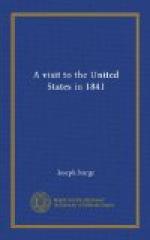“Having been found guilty by the court, in their own district, they were sent down to Canton, by order of the Emperor, to the Unchat-see, (criminal judge) to be confronted with the young French sailor. This trial is represented in the painting. The prisoners were taken out of their cages, as is seen in the foreground. The Frenchman recognized seventeen out of the twenty-four; but when the passenger, who had been his friend, was brought in, the two eagerly embraced each other, which scene is also portrayed in the painting. An explanation of this extraordinary act was made to the judge, and the man forthwith set at liberty. A purse was made up for him by the Chinese and foreigners, and he was soon on his way homeward. The seventeen were decapitated, in a few days, in the presence of the foreigners; the captain, was to be put to a ‘lingering death,’ the punishment of traitors, and the stolen treasures were restored.”
I do not quote the above for the sake of the anecdote, though the relation is authentic, but as, affording a striking illustration of the advanced civilization of the Chinese. It shows that the supremacy of the law is universal, and its administration efficient. The criminals, in this instance, are promptly seized, tried, and condemned on strong evidence; but, before they are executed, reference is made to the distant metropolis, Pekin. Here it is observed, that the most important witness was not ‘confronted with the prisoners,’ and they are forthwith directed to be conveyed to Canton, to be examined in his presence. Seventeen are recognized by him and are executed. The rest escape. Now this is just what might have taken place under the best ordered governments of Europe. The humane maxims of British jurisprudence, if not acknowledged in theory, may be here witnessed in practical operation, and the single circumstance of referring capital convictions to the Emperor, in his distant metropolis, for confirmation, before they are carried into effect, shows a respect for human life, even in the persons of criminals, which is one of the surest tokens of a high state of civilization. Such is the criminal jurisprudence of China, in practice; in theory, its just praise has been awarded, some years ago, by an able writer in the Edinburgh Review. He says:—
“The most remarkable thing in this code, is its great reasonableness, clearness, and consistency; the businesslike brevity and directness of the various provisions, and the plainness and moderation of the language in which they are expressed. It is a clear, concise, and distinct series of enactments, savoring throughout of practical judgment and European good sense. When we turn from the ravings of the Zendavesta, or the Puranas, to the tone of sense and of business of this Chinese collection, we seem to be passing from darkness to light—from the drivellings of dotage to the exercise of an improved




